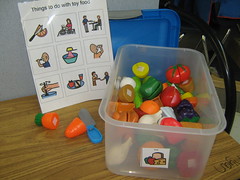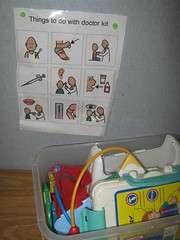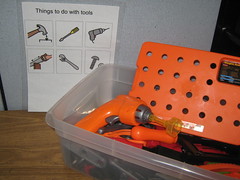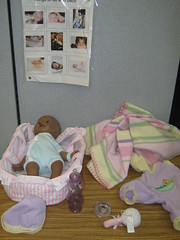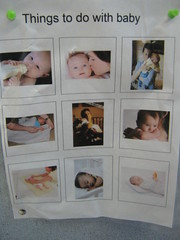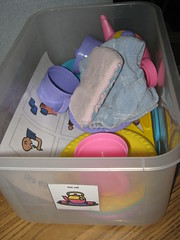In my school district, elementary schools are typically allotted four CBI (Community based instruction) trips each school year. Many teachers take one each grading period but I usually choose to take all four toward the end of the year. I know that if I only do something once every few months, I forget a lot between times - but if I do it several times consecutively it gets ingrained in my brain a little better, so I think that taking all four trips close together increases the likelihood of generalization for my students.
This means that I spend a lot of time during the year teaching community skills without actually going into the community. I generally focus on these areas:
- community signs - recognizing and identifying them and what they mean
- community places - recognizing and identifying them and understanding what we do and see in different places
- community helpers - recognizing and identifying them and understanding what they do
- practicing skills like addressing/stamping mail, ordering from a menu, shopping from a list, paying for things
In this blog post I will share some of my favorite resources for the first three categories mentioned above. I'm working on a follow up post to address the last one :-)
Most of the resources mentioned here are store-bought but community instruction materials are pretty easy to DIY - take a walk through your community and take your own pictures of buildings, people, etc. A child with autism is much more likely to recognize an actual picture of the post office in their own town than they are a generic "post office" photo or drawing! Search online using flickr or google images (make sure you look for pictures licensed under a
creative commons license so you aren't stealing copyrighted work!) to find pictures. Use those pictures to make flashcards, worksheets, etc.
You can also take your own pictures for social stories or your own video for video modeling - just make sure you get permission from the store/doctor/post office/whatever before you do so. Usually when you explain that you are making a video or picture-story for a child/children with a disability to learn about shopping/visiting the doctor/going to the post office/whatever, people are more than happy to cooperate and allow you to photograph/video. Some places, though, have to get permission from corporate offices before allowing any photography or video to be taken - so call ahead!
 Signs
Signs
I have, use and love PCI's
Survival Signs program (software, flashcards, large signs, bingo games, reproducible worksheets and board game - they are all awesome). The worksheets have students match the picture parts of the sign to the words on the sign, which works on word recognition and plays to the visual strengths of kids with autism. I love, though, that the curriculum focuses not just on recognizing the word/picture but also on things like where you see the signs, what to do when you see them, and comprehension of what the sign *means* and not just what is *says*

I also like the Conover Company's iPod/iPad app,
Community Signs and Words for many of the same reasons - the videos explain what the signs say, mean and what to do when you see them. Conover Company has several apps as well as comuputer software programs that I covet ... for example: Clothing Store Signs and Words, Emergency Signs and Words, Grocery Signs and Words, Information Signs and Words, Pharmacy Signs and Words, Public Transportation Signs and Words, Restaurant Signs and Words, Safety Signs and Words, School Signs and Words, Shopping Signs and Words, Survival Signs and Words and Words that Direct ... and one day when I win the lottery I will surely purchase them all!
Attainment has a set of
Survival Sign Software that includes Basic Signs, Safety Signs and Community Signs. It uses video to teach, has quizzes where the student had to choose the correct sign and (my students' favorite part) they get to put signs in photos of real-life scenes. The software also comes with printable activities.
 Remedia Publications
Remedia Publications has
flashcards, a workbook and a video - I have, use and love the flashcards and workbook, just discovered the video while writing this post - it is now on my wishlist!!
Here is a
survival sign activity from
Speaking of Speech
Trend has a great bulletin board set of
Safety Signs and Symbols, a
learning chart, and
Here is an activity I found on
Boardmaker Share:
Survival Signs in my Community (*requires Boardmaker Studio)
Community Places

I absolutely love the stories in the
Life Skills Readers by
Attainment - they have photographs and simple social-story type text describing common places and things we do there. There's also a section on signs. One of my favorite things about the Attainment stuff is that the book comes with a CD of the entire book in PDF format - which allows me to print each student or group a color copy of the pages. I do not have the software that goes with this series (again, just discovered it while getting the link for this blog entry) but it looks like it would be great for the interactive whiteboard - add another thing to my wishlist!
Also from Attainment is
Community Success which has illustrated social skills, "OK" and "Not OK" examples, and step-by-step pictures that I use to make my own social stories, checklists, shopping lists, visual prompts, and more. For example, there is a little picture of each department in a grocery or department store, pictures for all of the steps involved in community outings (find items on your list, place items on counter, give cashier money, wait for change, say thank you, etc.). There are a few assessment pages in the back of the book as well.
Another one from Attainment is the
Stepping Out curriculum. My favorite thing about this is that is came with prompting/cuing materials like a money-counting guide, ID cards, picture prompt cards, etc. It also has worksheets that would be super fantastic for older and/or higher functioning students than mine - but they do provide a great framework and starting point for making similar activities for my students.
 Model Me Kids
Model Me Kids has a great video modeling iPod /iPad app (and DVD as well) -
Going Places
One of our class favorites, Mr. John from
Special Kids, has a great video called "Let's Go To" - I highly recommend ALL of the Special Kids videos. They are great for video modeling, vocabulary, and spelling.
PCI has-
Community Places Bingo is another great way to practice idenitfying places in the community as well as the services provided by each place. (They also have Community Helpers Bingo)
Community Helpers
Stages (Language Builder) flashcards are one of my staples - and their
Occupations flashcards are a MUST. There are two flashcards (a male and female) for each of over 50 careers - and they are actual photographs. Stages also has a
theme kit which includes the occupation flashcards, posters, BINGO and memory matching game cards.
Trend's
Community Helper bulletin board set also includes photograph-type pictures of real people - and they have flashcards and border to match.
Attainment's
Members of the Community has some great pictures of different people who work in the community as well, with activities and worksheets to go along.
I love the DK book
Jobs People Do because it has pictures of children dressed up for each career and my kids like looking at the pictures.
People and Places

Most of my favorite materials are the ones that tie together the people and places. I usually bring these out after the student is able to identify/label the people and the places separately - then we start tying it all together by talking about where people work, what tools they use, things we see at the different places, etc.
There is an awesome
pocket chart set from
Learning Resources that has transportation, tools, people, buildings and street signs that students can sort.
Lakeshore has a
Community & Careers Theme Box with lots of cool stuff in it - bingo type boards of things we see at different places, little buildings and cards to sort what we see where (my favorite part), maps and more.
One of my favorite resources from Lakeshore is now discontinued -
Let's Talk About Social Studies discussion cards include a set on community helpers/tools/places. If you ever see them at a yard sale or anything, I'd recommend grabbing them!
These flashcards have pictures of people, things, and places in the community on one side and "WH" questions on the other side - they are great once a student can label the people/places/things in the community!
And last but CERTAINLY not least, Karen Cox has a plethora of
activities and resources on her website!
What are some of your favorite resources for teaching students about the community?
